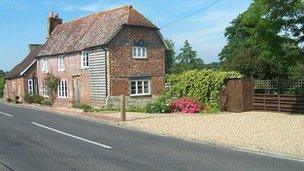Shakespeare 'may have been a humble schoolmaster'
- Published

William Shakespeare is known to have been sponsored by Henry Wriothesley
William Shakespeare may have spent some of his "lost" early years working as a schoolmaster in a Hampshire village.
Local historians in Titchfield near Southampton believe the Bard worked as a schoolmaster at a school there for three years between 1589 and 1592.
The theory has its roots in his relationship with the third Earl of Southampton, Henry Wriothesley, who sponsored Shakespeare for a time.
It may answer the mystery of where the author was between 1589 and 1592.
Academics have long tried to fill in the details of Shakespeare's lost years between the birth of his twins in 1585, and 1592 when he was recorded as being in London.
'Jigsaw'
Local historian Ken Groves says it has been established beyond reasonable doubt that a house near the historic Titchfield Abbey, known as Place House Cottage, was a schoolhouse at the time. And he also believes the buildings were owned by Henry Wriothesley's family.
He highlights this evidence alongside a claim from the 17th Century writer John Aubrey that Shakespeare worked as a schoolmaster.
Aubrey wrote about England's most famous dramatist in his book Brief Lives, basing his claim on verbal evidence from the son of a contemporary writer of Shakespeare who told him the Bard had been a teacher in rural England.
Henry Wriothesley is known to have sponsored Shakespeare for a time and Imperial College Professor John Dover Wilson wrote in 1933 that Shakespeare had worked as a tutor for the third Earl of Southampton.

The old grammar school in Titchfield is now known as Place House Cottage
The theory that Shakespeare worked as a school teacher whilst being sponsored by the Earl of Southampton in the Titchfield area has also been advanced by academic and author Stewart Trotter.
In his blog, Shakespeare in Titchfield, external, he said the village "was the favourite country seat of the Southampton family".
"All of its members are buried in the crypt of St. Peter's Church, Titchfield. It was customary, at the time, for a writer to lodge in the household of his patron as part of his 'patronage'."
Mr Groves, a retired physicist, said: "All we are doing is putting the pieces of the jigsaw together.
"If he was a schoolmaster he probably would have had to have had a close connection with a noble family.
"We have a school that was there at the right time, which had a connection with one of the earls who we know Shakespeare had a connection with.
"And we have the written evidence in Brief Lives that Shakespeare was a teacher."
He added: "The school itself was run as a monastic school and quite a small one with a maximum of about 12 pupils.
"They would have taught Latin, religious studies, grammar and a bit of maths."
Marriage of Henry VI
Mr Groves says there are a number of interesting connections between the Shakespeare family and key noblemen and women who would have been living in the area around Titchfield at the time.
And there are some clues in the material that Shakespeare produced in his early years.
He says it is telling that one of Shakespeare's earliest plays was based on the life of a lesser known king, Henry VI who got married to Margaret Anjou in Titchfield Abbey in 1445.
"If he was here," says Mr Groves, "you can just imagine the stories that the locals would have told about that event."
Kevin Fraser, chairman of the Titchfield Festival Theatre, said there was evidence Shakespeare lived in Stratford, that he lived in London and now Titchfield.
He added: "There is a quite a body of evidence coming through now. It's not just a rustic fantasy. There really is quite a bit of heavyweight evidence coming through now."
This includes claims he worked with some of his contemporaries such as Thomas Nashe and Robert Greene in the large library of the Earl of Southampton.
His organisation is applying for a heritage lottery fund grant to fund a Shakespeare trail around the area. The trail would bring the key elements together, The Barn, Place House (Titchfield Abbey) The Old Grammar School and the Southampton tombs in St Peters Church in the centre of Titchfield.
All these would be linked with a downloadable app and an interactive exhibition in the Great Barn and small Elizabethan style theatre.
But Prof Michael Dobson, director of the Shakespeare Institute, said although there had been speculation that Shakespeare had been a guest of the Earl of Southampton, he thought it was highly unlikely that he spent much time in the countryside.
"When Shakespeare pops up in London in 1592, he's already an up and coming playwright."
- Published1 April 2013
- Published8 June 2011